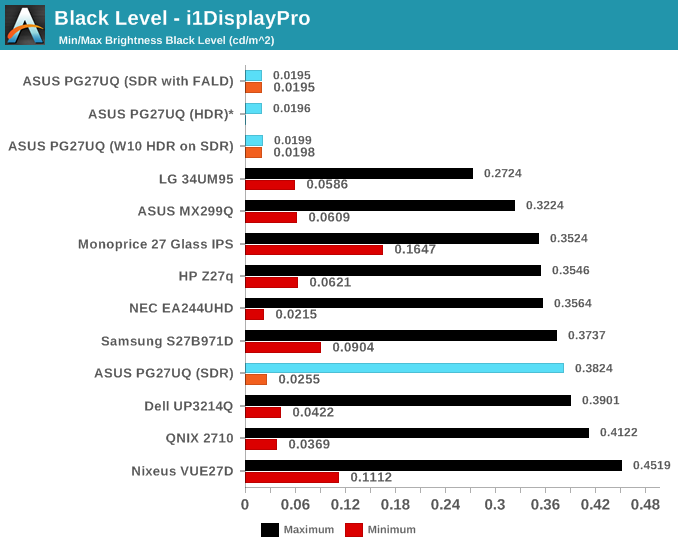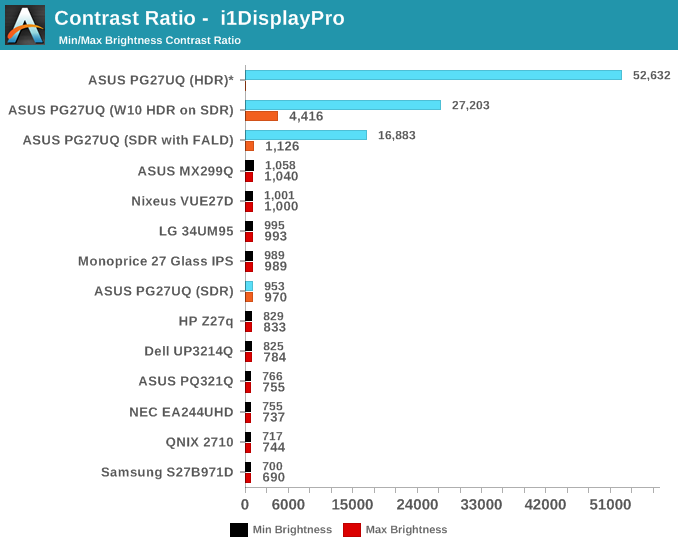The Asus ROG Swift PG27UQ G-SYNC HDR Monitor Review: Gaming With All The Bells and Whistles
by Nate Oh on October 2, 2018 10:00 AM EST- Posted in
- Monitors
- Displays
- Asus
- NVIDIA
- G-Sync
- PG27UQ
- ROG Swift PG27UQ
- G-Sync HDR
Brightness and Contrast
Going straight into the brightness and contrast metrics, we know HDR's calling card is to permit those bright whites and dark blacks. For DisplayHDR 1000, and UHD Premium, 1000 nits (the common non-SI term for cd/m2) is the requirement. So for brightness of white levels, it's no surprise that in HDR mode the PG27UQ reaches that coveted mark.
Outside of HDR, brightness is also useful in gauging visibility/usability in conditions of bright and direct ambient light, i.e. outdoors. For moderately lit indoor use, the typical 200 to 300 nit range of desktop monitors is more than sufficient. In terms of factory defaults, the PG27UQ is set at 80 for brightness, which is around 266 nits. 1000 nits is much too bright for day-to-day usage, as is 500 nits.

*In HDR mode, there is an adjustable 'reference white' setting, defaulted at 80 nits, instead of a brightness setting. At that default setting, the PG27UQ displayed the HDR test pattern at 1032 nits.
Because HDR has a static 'reference white' level instead of brightness, there isn't really an equivalent to minimum brightness white level as it isn't utilized in the same way; for the PG27UQ, reference white can be set between 20 to 300 nits.
Otherwise, enabling the Windows 10 'HDR and Wide Color Gamut' mode puts the monitor into its HDR mode; additionally, that Windows 10 setting provides a brightness slider governing SDR content while in HDR mode. So at 100% SDR brightness, the display pushes past 500 nits. For users, it works nicely to avoid SDR dimness when HDR is enabled, and also providing the option to boost up to much higher brightness if desired.

*Represents black levels corresponding to the default 'reference white' setting of 80 nits.
IPS-type panels are often known for their 'backlight bleed' and so relatively higher black levels. Without its local dimming capability, the PG27UQ isn't much of an exception. Enabling variable backlighting (FALD) in the OSD brings the black levels to HDR tier performance, and can be enabled on SDR mode at the cost of maximum brightness white levels.

*Contrast ratios calculated from default reference white of 80 nits
The good range between bright whites and dark blacks translate into high contrast ratios for the PG27UQ. While we don't have any other HDR monitors for comparison, the contrast ratios are really in their own class, especially as only HDR content will take advantage of the brightness and be (properly) displayed. Otherwise, in pure SDR mode, the PG27UQ resembles a solid IPS-type SDR monitor. Just enabling the direct LED backlighting in SDR mode improves contrasts considerably on the strength of its black levels.










91 Comments
View All Comments
DanNeely - Tuesday, October 2, 2018 - link
Because I use the same system for gaming and general desktop use. My main display is my biggest and best monitor and thus used for both. At some hypothetical point in time if I had a pair of high end displays as my both my center and as one of my side displays having different ones as my gaming and desktop use might be an option. But because I'd still be using the other as a secondary display not switching off/absolutely ignoring it, I'd still probably want my main screen to be the center one for both roles so I'd have secondaries to either side; so I'd probably still want the same for both. If I were to end up with both a 4k display and an ultrawide - in which case the best one to game on would vary by title it might become a moot point. (Or I could go 4 screens with small ones on each side and 2 copies of my chat app open I suppose.)Impulses - Tuesday, October 2, 2018 - link
Still using the 32" Predator?edzieba - Tuesday, October 2, 2018 - link
"Why not get an equally capable OLED/QLED at a much bigger size for less money ?"Because there are no feature equivalent devices.
TVs do not actually accept an update rate of 120Hz, they will operate at 60Hz and either just do double-pulse backlighting or add their own internal interpolation. QLED 'HDR' desktop monitors lack the FALD backlight, so are not HDR monitors (just SDR panels that accept and compress a HDR signal).
wolrah - Tuesday, October 2, 2018 - link
A small subset of TVs actually do support native 120Hz inputs, but so far I've only seen that supported at 1080p due to HDMI bandwidth limitations.For a while it was just a few specific Sony models that supported proper 1080p120 but all the 2017/2018 LG OLEDs do as well as some of the higher end Vizios and a few others.
resiroth - Monday, October 8, 2018 - link
LG OLED TVs accept 120hz (and actually display true 120 FPS) but at a lower 1080p resolution. They also do 4K/60 of course. Not a great substitute though. If I were spending so much on a monitor I would demand it be oled though. Otherwise I’m spending 1500-1600 more than a 1440p monitor just to get 4K. I mean, cool? But why not go 2000-2500 more and get something actually unique, a 4K 144hz OLED HDR monitor that will be useful for 10 years or so.This thing will be obsolete the second oled monitors come out. There simply is no comparison.
Impulses - Tuesday, October 2, 2018 - link
Regardless of all the technical refresh rate limitations already pointed out, not everyone wants to go that big. 40" is already kinda huge for a desktop display; anything larger takes over the desk, makes it tough to have any side displays, and forces a lot more window management that's just not optimal for people that use their PC for anything but gaming.I'd rather have a 1440p 165Hz 27" & 4K 32" on moving arms even than a single 4K 50"+ display with a lower DPI than even my old 1920x1200 24"...
lilkwarrior - Monday, October 8, 2018 - link
To be fair, most would rather have a 4K ultra-wide (LG) or 1440p Ultrawide rather than multiple displays or a TV.5K is an exception since more room for controls for video work & etc is a good compromise for some to the productive convenience of more horizontal real estate an ultrawide provides.
Most enthusiasts are waiting for HDMI 2.1 to upgrade, so this monitor & current TVs this year are DOA.
milkod2001 - Tuesday, October 2, 2018 - link
This is nearly perfect. Still way overpriced what it is. I'd like to get similar but at 32'' size, 100Hz would be enough, don't need this fancy useless stand with holographic if price can be much cheaper, let it be factory calibrated, good enough for bit of Photoshop and also games. All at $1200 max. Wonder how long we have to wait for something like that.milkod2001 - Tuesday, October 2, 2018 - link
Forgot to mention it would obviously be 4k. The closest appears to be: BenQ PD3200U but it is only 60Hz monitor and 2017 model. Would want something newer and with 100Hz.imaheadcase - Tuesday, October 2, 2018 - link
To be fair, a mix of photoshop an also games at that screen res 60Hz would prob be enough since can't push modern games that high for MOST part. I have that Acer Z35P 120Hz monitor, and even with 1080Ti its hard pressed to get lots of games max it out. That is at 3440x1440.My 2nd "work" monitor next to it is the awesome Dell U3818DW (38 inches) @ 3840x1500 60Hz I actually prefer the dell to strategy games because of size, because FPS is not as huge concern.
But playing Pubg on the Acer 120Hz will get 80-90fps